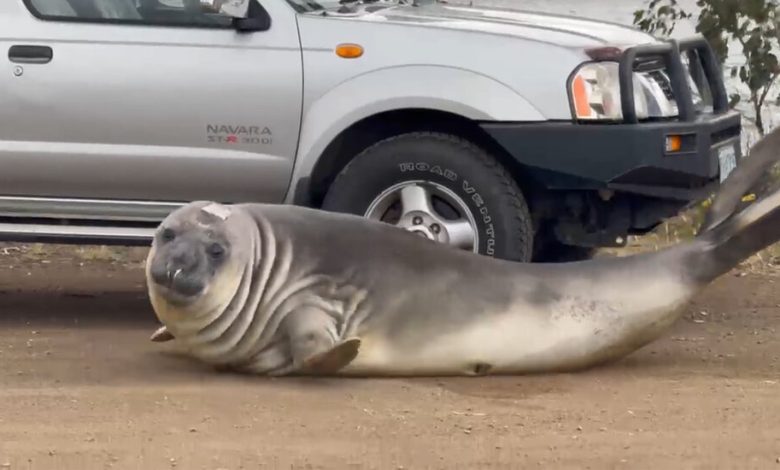Tasmania Falls for Neil the Seal, a 1,000 Pound Beach Bum

He has shown up uninvited on doorsteps, slept on the road and prompted calls to the police. But the residents of a coastal region in southern Tasmania, Australia, have been unusually forgiving to their interloper — after all, he is a seal.
The more than 1,300 pound southern elephant seal, whom locals have affectionately named Neil (the Seal), appears to have gained public attention in Australia last year when he slithered into a beachside neighborhood near Hobart, the capital of the island state of Tasmania, where he rollicked with traffic cones and basked sluggishly in the sun.
Then, last month, Neil decided to take a nap in front of a woman’s car, thwarting her plans to leave the house. “I think it’s going to go down in the books as the best excuse in history not to go to work,” the woman said at the time. Neil has since garnered global fame for his antics — enjoying a shower from a garden hose, growling belly up on a doorstep and appearing to charge toward a group of people on a lawn.
“I’ve never, ever seen anything like it,” said Sonya Hay, who lives in a southern Tasmanian town where Neil was spotted this month. “He’s basically the talk of the town.”
Though it is not unusual for southern elephant seals to come ashore — the marine mammals spend several weeks each year on land to molt their fur — Neil is probably unique in his visits to communities near Hobart, said Clive R. McMahon, an ecologist at the Sydney Institute of Marine Science who has studied the behavior of elephant seals.
Unlike other seals born in nearby wild colonies, Neil, who is just a few years old, was born on a beach near the city, possibly because his mother was lost, Dr. McMahon said. But without other young seals to socialize and swim with, Neil most likely had a lonely youth. Elephant seals, Dr. McMahon added, “will habitually return to the places where they were born — so that’s probably why Neil thinks this is his home.”
There are always concerns, however, when wild animals, especially those as large as Neil, get too comfortable around humans. This year, the authorities in Connecticut, citing safety concerns for travelers, killed a moose that wandered into Bradley Airport. Last year, a 1,300 pound walrus named Freya suffered the same fate after climbing onto piers and boats off the coast of Oslo, Norway. And last year, the authorities already had to relocate Neil after he was harassed by dogs and people, the Department of Natural Resources and Environment Tasmania said in a statement in April.
The department warned that Neil would eventually grow to more than 16 feet long and weigh more than 7,500 pounds, becoming potentially dangerous if provoked. “It’s critical he doesn’t get used to being near humans,” Sam Thalmann, a wildlife biologist with the department, said at the time. The department would not provide further information on Neil, nor respond to questions on whether intervention could be necessary again in the future.
Dr. McMahon, the Sydney-based ecologist, said it was likely that in the coming years, Neil, whom scientists track using a GPS stuck to the fur on his head, would continue returning to the Hobart region, unless by some stroke of luck, or a very long swim, Neil encountered another group of elephant seals he could breed with. “The prospects,” Dr. McMahon added, “don’t look great for him.”
For now, Neil appears to be spending his days lingering near a fish and chip shop in a rural community about 25 miles east of Hobart, where he alternates between a boat ramp and the middle of the road.
“He is very placid, very funny; he doesn’t move,” said Sandra Wray, the owner of the restaurant, recounting how her staff members, concerned for Neil’s safety, notified the police, who helped shepherd the seal back into the water using a siren. His gray color, she added, “is almost the same color as the bitumen” which would make it challenging for a driver to spot the seal on the road.
The Tasmania Police did not respond to questions about how many complaints they had received, or whether they had encountered any other similar situations involving wild animals.
Some residents said that while they had heard the odd complaint, Neil was generally beloved by the community and seemed to act out only when people came too close.
“I thought he was dead to be quite honest at first, because he was just laying there,” Stephen Godfrey, who lives in another neighborhood where Neil has been seen, said of the first time he spotted Neil on the sand near his home. “But then he started moving around.”
“He’s been here on and off for a while,” said Mr. Godfrey, 34, adding that he hoped Neil would continue to visit the seaside region where he had brought awe to many of the residents. “He’s sort of part of the community now.”





